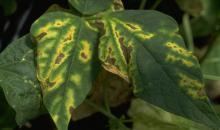Order Actinomycetales Rank Species | Phylum Actinobacteria Suborder Micrococcineae | |
 | ||
Scientific name Curtobacterium flaccumfaciens Similar Curtobacterium, Clavibacter michiganensis, Clavibacter, Xylophilus ampelinus, Burkholderia caryophylli | ||
Curtobacterium flaccumfaciens is a Gram-positive soil bacterium that causes disease on a variety of plants. Gram-positive bacterium characteristics include small irregular rods, lateral flagella, the ability to persist in aerobic environments, and cells containing catalase. In the interest of studying pathogenicity in plants, the species Curtobacterium flaccumfaciens is broken down further into pathovars, which help to better describe the pathogen.
Contents
Hosts and Symptoms
Curtobacterium flaccumfacien is a bacterial wilt pathogen. The hallmark symptoms of bacterial wilt are leaf and petiole wilting. Chlorosis of the leaf and tissue occurs due to the lack of water transport. Curtobacterium flaccumfaciens as a species has a wide host range not limited to kidney beans, soybeans, tulips, and tomatoes. However, the species is artificially separated into a pathovar based on host range and symptoms. One of the economically important pathovars is Curtobacterium flaccumfaciens pv. Flaccumfaciens. This pathovar is classified as bacterial wilt and has a primary host range of the genus Phaseolus (beans), but the pathogen can infect many other species of the Fabaceae. In beans the symptoms can be devastating to the crop yield. These beans have severe foliage wilting and chlorosis.
One ornamental example is Curtobacterium flaccumfaciens pv. oortii. The primary host are plants from the genus Tulipa (Tulip). Although the host range differs,the symptoms are relatively similar. During flowering typical symptoms of dehydration are observed. Similarly to beans, the tulips get wilt. In severe cases, the plant eventually fails to recover from wilting and dies.
Disease cycle
Survival Curtobacterium flaccumfaciens can overwinter in plant debris, diseased plants, wild hosts, seeds, or vegetative propagative organs. The bacteria can survive only a couple of weeks as free bacteria in soil. Multiple factors go into survival of a bacterial population, including temperature, humidity, and soil characteristics. Infected seeds cannot be used for susceptible bean crops because Curtobacterium flaccumfaciens pv. flaccumfaciens has been known to survive in dried bean pods from five years and up to 24 years in laboratory conditions. Different pathovars survive in slightly different ways. For example, Curtobacterium flaccumfaciens pv. oortii survive in the vegetative propagative organs (bulbs) rather than in the seeds, like Curtobacterium flaccumfaciens pv. flaccumfaciens.
Dispersal Curtobacterium flaccumfaciens causes wilting at high populations and disperses in many ways. The bacteria multiply relatively quickly which increases the possibility that Curtobacterium flaccumfaciens can shed from dying or dead plant material. The pathogen is normally dispersed via agricultural practices such as, planting saved seed and through farm equipment. In the case of beans & tulips these practices move the propagule during overwriting phase of their life cycles. This is effective dispersal for the pathogen. Infection Curtobacterium flaccumfaciens usually enters the plant though a wound. Natural wounds (created by excision of flowers or genesis of lateral roots) and unnatural wounds could become entry sites. There are no reports of vectors, but the nematode Meloidogyne incognita may assist entry by providing unnatural wounds.
Management
Management varies for each between hosts. For this purpose, we will look specifically at the detection and control methods of Curtobacterium flaccumfaciens pv. flaccumfaciens. Since most plant pathogens are Gram-negative detection of Gram-positive bacterium, using methods such as the KOH test, is a beginners diagnostic tool used to identify this bacterium. Bacteria may be detected beneath the seedcoat by means of a combined cultural and slide agglutination test. Bean seed from countries where the disease is known to occur should be inspected for discoloration of the seedcoat. Immunofluorescence staining can also be used to detect the bacterium in contaminated seed lots. Control may be affected by using disease-free seed and crop rotations. Seeds grown in dry climates are usually free from infection and are, therefore, recommended for distribution. The strongest control regulations handed down by the European and Mediterranean Plant Protection (EPPO) to date was a quarantine procedure. There is little resistance available commercially to Curtobacterium flaccumfaciens pv. flaccumfaciens and antibiotics are ineffective.
